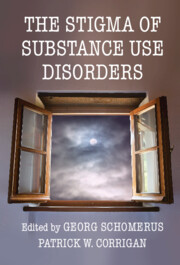Book contents
- The Stigma of Substance Use Disorders
- The Stigma of Substance Use Disorders
- Copyright page
- Contents
- Figures
- Tables
- Contributors
- Chapter 1 Understanding the Stigma of Substance Use Disorders
- Chapter 2 My Experience with the Stigma of Substance Use
- Chapter 3 Substance Use Stigma and Policy
- Chapter 4 Experiences of Stigma and Criminal In/Justice among People Who Use Substances
- Chapter 5 Substance Use Disorders, Stigma, and Ethics
- Chapter 6 Intersectional Stigma in Substance Use Disorders
- Chapter 7 International Perspectives on Stigma toward People with Substance Use Disorders
- Chapter 8 Using Community-Based Participatory Research to Address the Stigma of Substance Use Disorder
- Chapter 9 Three Competing Agendas of Addressing Stigma of Substance Use Disorder
- Chapter 10 The Benefits of Disclosure
- Chapter 11 The Role of Peers in SUD Stigma Change
- Chapter 12 The Role of Media Reporting for Substance Use Stigma
- Chapter 13 Reducing Substance Use Stigma in Health Care
- Chapter 14 Final Considerations and Future Directions for Erasing the Stigma of Substance Use Disorders
- Index
- References
Chapter 6 - Intersectional Stigma in Substance Use Disorders
Published online by Cambridge University Press: 23 June 2022
- The Stigma of Substance Use Disorders
- The Stigma of Substance Use Disorders
- Copyright page
- Contents
- Figures
- Tables
- Contributors
- Chapter 1 Understanding the Stigma of Substance Use Disorders
- Chapter 2 My Experience with the Stigma of Substance Use
- Chapter 3 Substance Use Stigma and Policy
- Chapter 4 Experiences of Stigma and Criminal In/Justice among People Who Use Substances
- Chapter 5 Substance Use Disorders, Stigma, and Ethics
- Chapter 6 Intersectional Stigma in Substance Use Disorders
- Chapter 7 International Perspectives on Stigma toward People with Substance Use Disorders
- Chapter 8 Using Community-Based Participatory Research to Address the Stigma of Substance Use Disorder
- Chapter 9 Three Competing Agendas of Addressing Stigma of Substance Use Disorder
- Chapter 10 The Benefits of Disclosure
- Chapter 11 The Role of Peers in SUD Stigma Change
- Chapter 12 The Role of Media Reporting for Substance Use Stigma
- Chapter 13 Reducing Substance Use Stigma in Health Care
- Chapter 14 Final Considerations and Future Directions for Erasing the Stigma of Substance Use Disorders
- Index
- References
Summary
Substance use disorders (SUD) often occur in companion to other stigmatized characteristics, e.g., lower socioeconomic status, employment status, criminal record, race, gender, sexual orientation, or comorbid physical condition. Isolating each of these conditions when addressing stigma might miss the complexity of injustice and discrimination in our society. The concept of intersectional stigma addresses the effect of combined disadvantageous positions. This chapter provides an overview of findings on SUD stigma at intersectionality’s classical focal points: the intersections of race, gender, sexual orientation, and socioeconomic status. We then discuss the following questions: does intersectional analysis of SUD stigma need to include additional attributes to fully capture the multifaceted nature of SUD stigma, and how can they be identified? Are there common denominators of SUD stigma that can be addressed with broader benefit? Finally, we present how intersectional analysis can result in practical interventions that might help people with SUD become more resilient to stigmatization.
- Type
- Chapter
- Information
- The Stigma of Substance Use Disorders , pp. 88 - 106Publisher: Cambridge University PressPrint publication year: 2022
References
- 2
- Cited by

